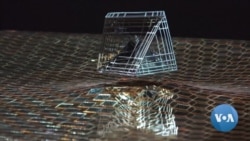A new exhibit at a California museum provides visitors with a modern version of the ancient Chinese art style, "shan shui hua." The name means “mountain water painting” in English.
The show is at the Chinese American Museum in Los Angeles. It is called Lightscapes: Re-envisioning the Shanshuihua.
The works show scenes of mountains, rivers and sometimes waterfalls. Chinese artists have been creating the brush and ink works for more than 1,000 years.
Artists Nick Dong and Chi-Tsung Wu found ways to connect the new, digital generation to this traditional kind of art. Their work captures the essence of the style in a new way.
Escape from reality
The exhibit forces the viewer to slow down and experience a different world. That was also one of the goals of shan shui hua artists from long ago.
Dong, who was born in Taiwan and now lives in Northern California, said, “Actually, it was for all these artists to create a world which they want to hide, avoid, escape from reality. So, they create a mountain (and) imagine they could live there.”
Dong and Wu are trained in both Chinese and Western art styles. They use experimental materials and light in their artworks included in the exhibit.
One work involves a slowly moving light directed at clear plastic boxes on a wall. The piece, created by Wu, is called Crystal City. Wu said, “If we see this through the light, through the different perspective, we could see there’s another world behind that.”
That other world Wu noted are shadows that look more solid than the plastic boxes. Wu said Crystal City is representative of the modern digital age.
“We spend most of our time in our daily life, no matter to work or to our social life or our entertainment, all on this cyberspace,” he said.
That space is an escape for many people -- similar to the shan shui hua paintings.
Philosophy and the spiritual
Dong and Wu’s art also employs magnets to raise and lower objects. The movement is meant to show that there is a force between all natural elements.
One art piece in the exhibit explores the individual’s relationship with the universe. To view Dong’s representation of heaven, one has to step into a room filled with mirrors from floor to ceiling. There is a small round seat in the middle of the room.
Dong said, “We’re all searching. We’re all longing for growth, become better and, ultimately, good enough to go to heaven.”
He added, “...Once you’ve entered the installation, at first you’ll see a lot of your reflection. But once you sit down, you trigger the mechanism of the room. The mirror actually starts to reflect, and you yourself will disappear within the space.”
The art pieces in the exhibit are ways in which both artists hope the modern-day viewer will be able to experience what the ancient artists were trying to communicate.
Lightscapes: Re-envisioning the Shanshuihua will remain open until November.
I’m Caty Weaver.
VOA’s Elizabeth Lee reported this story. Caty Weaver adapted it for VOA Learning English. Ashley Thompson was the editor.
____________________________________________________________
Words in This Story
essence - n. the basic nature of a thing : the quality or qualities that make a thing what it is
perspective - n. a way of thinking about and understanding something (such as a particular issue or life in general)
reflection - n. an image that is seen in a mirror or on a shiny surface
trigger - n. a similar movable part by which a mechanism is made active









